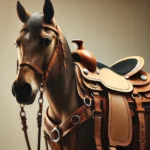Lunging is the method of exercising a horse in circles on an extended line or rope. It is step one to establishing clear communication together with your horse.
Lunging a horse is a course of that should be realized and practiced persistently so as to take action proficiently. Nonetheless, when you’ve mastered the lunging technique, it’s a very helpful instrument to have in your repertoire. Let’s start the method of lunging.
A horse might be free lunged in a spherical yard with out tools. Nonetheless, familiarizing your self with the tools forward of time is beneficial. This lets you study correct use of the tools earlier than including the complexity of maneuvering the horse.
Gear Required for Lunging a Horse
The next tools is required for lunging a horse.
- Lunge line-a lengthy size rein made from flat webbing, often 10m to 12m in size. Rope may additionally be used.
- Cavesson-similar to a halter, but it surely has rings connected for securing the lunge line.
- Lunge whip-a lengthy whip, usually 2m in size with an extended lash connected to assist keep a relentless tempo with the horse.
- Curler-similar to a surcingle that goes on the horse’s again and does up with a girth. Just like the cavesson, it additionally has rings connected at numerous ranges to permit the usage of facet reins.
- Aspect reins-reins that may be adjusted to various lengths, relying on the scale, form and training degree of the horse. Aspect reins often have an elastic or rubber piece inserted in them to permit for some stretch. These reins have clips for becoming a member of them to the horse’s bit.
- Bridle (optionally available) -usually used if facet reins are getting used.
- Stable boots, helmet, and gloves (for your self, in fact)
Exercising Security when Lunging a Horse
Your security is of paramount significance when working with horses. It’s important that you simply keep in mind the placement of your lunge line always when lunging a horse.
Toes and palms tangled within the free finish of the lunge line are frequent causes of accidents. Due to this fact, by no means wrap the lunge line round your hand or by means of the loop on the finish. Fold the road over on itself within the palm of your hand in order that it may be fed out and gathered in simply. Now, you might be prepared to begin lunging a horse!
- The newbie handler ought to study to lunge with a properly educated, quiet horse and an teacher or different educated equestrian there to oversee. An informed horse will know voice instructions. This can make the lunging course of simpler so that you can study.
- Entry to a spherical yard or an enclosed sq. yard is beneficial.
- Maintain the lunge line within the hand within the course the horse is touring. If the horse is touring left, the lunge line is within the left hand; the lunge whip within the different. The lunge line ought to be connected to the middle ring on the cavesson.
- The right place for lunging a horse will type a triangle. You may be the apex of the triangle and the horse’s shoulders and hips will type the opposite two angles. Try to be positioned roughly in step with the shoulders of the horse. The horse ought to journey alongside properly if you find yourself on this place.
- Start the lunging course of with you and the horse within the middle of the spherical yard.
- Lead the horse ahead together with your left hand whereas remaining within the middle of the circle. Concurrently feed the lunge line and encourage the horse to stroll ahead with the whip.
- The whip is in an lively place when it’s parallel to the bottom, pointing to the rump of the horse. Being lively means you might be encouraging the horse ahead. The whip is in a passive place when the lash finish of the whip is pointed in direction of the bottom and angled barely away from the rump of the horse. The whip ought to be in a passive place if you find yourself asking the horse to decelerate.
- Utilizing voice instructions, ask the horse to make transition upward as soon as out on the circle. These voice instructions ought to be brisk and energetic for upwards, whereas a slower, diminishing tone is efficient for downward transitions. For instance, a brisk “WALK ON” encourages the horse to stroll out, and a slower, quieter, “WA-A-LK” or “WA-A-LK -ING” is best for the downward transition.
- Physique placement may encourage transition. Stepping barely in direction of the pinnacle of the horse encourages it to decelerate, and stepping in direction of the rump of the horse encourages it to go ahead.
- The horse ought to be requested to halt in an effort to change course. You’ll collect the lunge rein, stroll out to the horse, and lead it to vary course.
- Every horse proprietor has a novel means of lunging. If you’re studying to lunge on a horse apart from your individual, ask to see the horse lunged so you already know the suitable voice instructions and physique placement for your self.
- Make sure you have a watch. Use it to time every transition in every course. The very last thing you need to do is make your horse one sided. For those who spend 5 minutes trotting to the left, it’s worthwhile to spend 5 minutes trotting to the precise.
These are the fundamental rules of lunging a horse, and keep in mind: Follow makes excellent! Pleased lunging!



